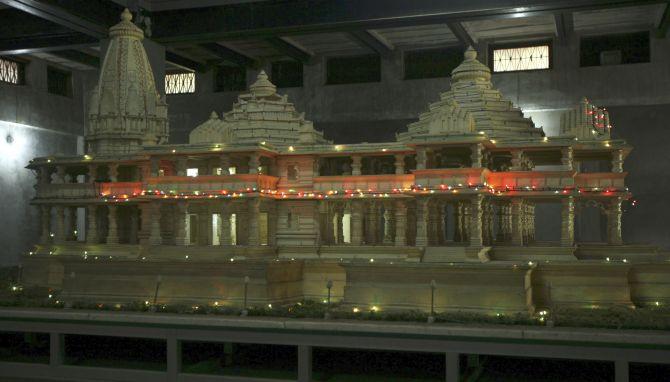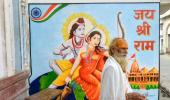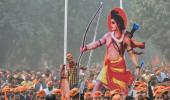'Whether Lord Ram is a historical person is not the subject before the court.'
'The court was asking every time if can anyone show the exact birthplace of Lord Ram on the basis of documents.'
'I have shown that on the basis of documents. And these documents are not (based) on my beliefs.'

The Ram Janambhoomi-Babri Masjid hearing before the five-judge Supreme Court Constitutional bench took a dramatic turn on Wednesday, October 16, after a book written by former Indian Police Service officer Acharya Kishore Kunal was introduced into the hearing by senior advocate Vikas Singh representing the All India Hindu Mahasabha.
When the book Ayodhya Revisited with a map showing Lord Ram's birthplace in Ayodhya was brought in as evidence, advocate Rajeev Dhavan, representing the Sunni Central Waqf Board, asked the bench what he should do with the map to which the bench said he can tear it up, which he then proceeded to do, reports the Press Trust of India.
So what was the evidence in the book about Lord Ram's birthplace? What did the former IPS officer write in his book that was controversial?
"The Vishwa Hindu Parishad never accepted my documentary evidence. They have the theory that Babur demolished the Ram Mandir and I don't think that way," Kishore Kunal tells Syed Firdaus Ashraf/Rediff.com.
What was the evidence from your book that was presented in the Supreme Court?
I have written two books, one in 2016 and in 2018. One book is Ayodhya Revisited with a foreword from Justice G B Patnaik, the former Chief Justice of India, and another book Ayodhya Beyond Adduced Evidence with a foreword by former Chief Justice of India M N Venkatachaliah. It was published in 2018.
I wrote the first book as a historian. In the second book I took up issues that are before the Supreme Court of India. And the senior advocate from the other side (Rajeev Dhavan) tore up the pages to stall the evidence before the court.
These books were submitted before the court three months ago.
But..
(Interrupts) The Supreme Court of India was asking if anyone can point out the exact birthplace of Lord Ram. With the help of documents researched worldwide, I have pointed out the exact place of Lord Ram's birth in Ayodhya.
When it was allowed by the court, it was torn up by Rajeev Dhavan.
My book and map were torn as it was evidence.
How did you come to the conclusion that Lord Ram was born at the particular place where the Babri Masjid once stood?
It is not based on my faith or imagination or my conjecture. I have six documentary evidences. The first documentary evidence is that one Syed Mohammad, who was a khatib and muezzin of the Babri Masjid wrote to the SHO of Ayodhya in 1858 that there was a mark of janmasthaan. And it was here that Hindus used to worship for thousands of years.
My second document is the testimony of Joseph Tiefenthaler who had come to India in 1745, remained here and died here. He visited Ayodhya in 1766 and his is the first account on this disputed shrine written in 1767.
He wrote about the Ram temple at the spot of the Babri Masjid. He writes that this temple was demolished by Aurangzeb and Hindus have not forgotten this fact.
But the popular belief is that the Babri Masjid was built by Mir Baqi who was Babur's general in 1528.
Joseph Tiefenthaler has written that the Babri Masjid was built by Aurangzeb. He also said some people say it was built by Babur. My thesis says Babur was a liberal ruler and he had nothing to do with the demolition of any temple.
What is the other evidence you are citing?
My third evidence for the Ram Mandir is that in some manuscripts of Ayodhya, which are now lying at Oxford university and the Vadodara Oriental Institute library and also Benares Hindu University, where it is written that the Ram janmasthaan is to the north-west of Sita Kunj and to the south-east of Sita Rasoi.
Sita Kunj exists to this date, but Sita Rasoi was demolished on December 6, 1992, with the Babri Masjid.
My fourth documentary evidence is Francis Buchanan's map of the Ram janmasthaan which I obtained from a British library by paying 200 pounds. In this it was mentioned beyond the three domes there is the Ram janmasthaan.
My fifth documentary evidence is of British archaeologist Patrick Carnegie who has written the summary of Ayodhya and given a description of the Ram janmasthaan. Then in 1950, one Shiv Shankar Lal prepared a map of the place and gave it to the Faizabad court.
On the basis of these six documents I proved that this was the Ram janmasthaan.
But the Muslim side says the trouble over the Ram Janambhoomi started in 1949 and the dispute was more about the Hanuman Garhi in Ayodhya which is located away from the Babri Masjid site.
Neither the Muslim party nor the Hindu party has researched enough on this issue. I have done enough research with documentary evidence to prove the place of the Ram janmasthaan.
Whether Lord Ram is a historical person is not the subject before the court. The court was asking every time if can anyone show the exact birthplace of Lord Ram on the basis of documents.
I have shown that on the basis of documents. And these documents are not (based) on my beliefs.
But you are very late in come up with this evidence.
The Vishwa Hindu Parishad never accepted my documentary evidence or theory. They have the theory that Babur demolished the Ram Mandir and I don't think that way.
Babur was a very liberal person and his liberalism has been accepted by Sanskrit pandits of this country. He has been compared to Raja Harishchandra. According to my research, Aurangzeb demolished the Ram Mandir and built the Babri Masjid.
This did not suit the VHP and therefore they did not accept my theory. If I had represented the VHP, this theory would have come up long back.
Fidai Khan, Aurangzeb's governor, demolished the Ram Mandir in Ayodhya in 1660. That was accepted by Sudhir Agarwal of the Allahabad high court.
In their foreword to both my books former Chief Justices G B Patnaik and M N Venkatachaliah too accepted that the Ram Mandir was demolished by Aurangzeb and not Babur. Babur had no role in it.
So why name it the Babri Masjid? How did that come about?
In 1813-1814, when Francis Buchanan surveyed Ayodhya, he wrore that there is general perception in Hindus that their temples in Kashi, Mathura and Ayodhya were demolished by Aurangzeb.
He writes that Aurangzeb had not demolished the Ram temple but five generation earlier it was Babur who had demolished it. Buchanan was a petty official and his writing remained unpopular.
In 1838, M Martin wrote Eastern India, in two volumes. He was an established historian of the British empire. When Martin published his book it was a verbatim copy of Buchanan's work.
I got the original transcript of Buchanan from the British Library and compared it with Martin's book. It was Martin who wrote that the Ram temple was demolished by Babur, on the basis of Buchanan's report.
Since then, the British world started writing that Babur demolished the Ram Mandir, and a liberal emperor like Babur's image was denigrated.









